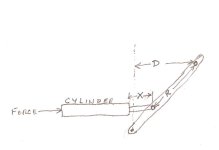raykos
Silver Member
Hello all,
Last summer I bought a JD2305, and since then it's kind of gotten me interested in knowing a little more about hydraulics. Does anybody know if there is a site, sort of like "Hydraulics for Dummies" available? Is there also anything available with formulas that would cover the drawing I've tried to make, in other words, if the rod of the cylinder travels 'X' amount, what distance 'D' would result, depending I guess on how far away, 'R' is?
I know it probably takes a long time to fully understand hydraulics, but as I said, I would like to start with the basics?
Thanks,
Ray
Last summer I bought a JD2305, and since then it's kind of gotten me interested in knowing a little more about hydraulics. Does anybody know if there is a site, sort of like "Hydraulics for Dummies" available? Is there also anything available with formulas that would cover the drawing I've tried to make, in other words, if the rod of the cylinder travels 'X' amount, what distance 'D' would result, depending I guess on how far away, 'R' is?
I know it probably takes a long time to fully understand hydraulics, but as I said, I would like to start with the basics?
Thanks,
Ray

